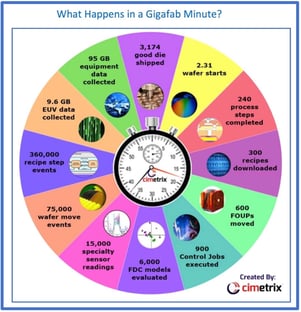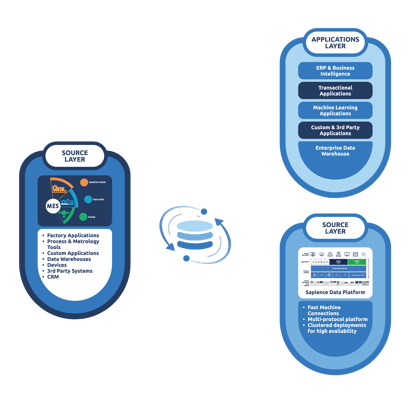The amount of data generated in a modern wafer fab is astounding – a terabyte of data can be produced in mere moments. And while the technologies harnessed to build modern chips are at the absolute bleeding edge and have been compared to the sacred by some reviewers, the technology used to gather data and monitor factory equipment is often, surprisingly, not.
 Ripping out and replacing shop floor applications is rarely done. And so, when a fab is built, its data acquisition and control architecture is generally as permanent as the bulk gas transports often seen hulking on the exterior. Modern software architecture has changed dramatically over the last 10 years. Yet the fab and its support systems are relatively static as compared to the process equipment needed to build the latest chips. The result of this imbalance and inertia is that fabs are full of equipment generating oceans of bits and bytes while the managers are struggling to stay afloat and man the oars. This problem only gets worse as management climbs the corporate ladder, or the mast, to extend the metaphor. The people in the corporate suites trying to understand and manage the realities going on in multiple fabs are absolutely inundated and clinging to debris in the deluge. No enterprise-level software system was ever designed to deal with this Noachian torrent of data. Out of this necessity fab managers have been employing data center technology and software architectures more commonly used to run social media sites and Amazon than to run factories.
Ripping out and replacing shop floor applications is rarely done. And so, when a fab is built, its data acquisition and control architecture is generally as permanent as the bulk gas transports often seen hulking on the exterior. Modern software architecture has changed dramatically over the last 10 years. Yet the fab and its support systems are relatively static as compared to the process equipment needed to build the latest chips. The result of this imbalance and inertia is that fabs are full of equipment generating oceans of bits and bytes while the managers are struggling to stay afloat and man the oars. This problem only gets worse as management climbs the corporate ladder, or the mast, to extend the metaphor. The people in the corporate suites trying to understand and manage the realities going on in multiple fabs are absolutely inundated and clinging to debris in the deluge. No enterprise-level software system was ever designed to deal with this Noachian torrent of data. Out of this necessity fab managers have been employing data center technology and software architectures more commonly used to run social media sites and Amazon than to run factories.
On the 8th of August 2022, Google Search went down for approximately 34 minutes due to a poorly planned software update. What is surprising about this is that it had been years since Search had suffered an outage like this, and more years hence. Google’s search page is the most heavily visited site on the internet and yet has one of the best availability metrics and performance history. There are undoubtedly many reasons for this success, but one of the most acclaimed is Google’s application server: Kubernetes. Named for the Greek word for helmsman or navigator, Kubernetes has become the standard application server for modern software architectures. Software purists will undoubtedly object, and say that Kubernetes, or K8s, merely orchestrates the deployment of software, but this is no longer true. K8s has become an ecosystem that hosts scores of other software products that do everything imaginable from compiling, testing, packaging, deploying and monitoring all the code required to keep a product like Google Search running.
Incidentally, many of the most successful K8s ecosystem products continue the nautical theme with names like Docker, Armada, and Helm.
In 2015, Google, in partnership with Docker and others, gifted the K8s technology to the open-source community at the Linux Foundation. The Cloud Native Compute Foundation (CNCF) project was announced at that time with the goal to unify the rather fragmented containerized approach to software deployments.
At PDF Solutions and the Cimetrix Connectivity Group, we saw this transformation happening and decided to get out in front of it. We’d been training shop floor engineers to drink from data firehoses for decades, showing them how to tap into the torrents and pull out just the manageable streams they required and were equipped to handle. Now, thanks to the CNCF, we can build software that handles far more data and still survives in the 24x7 environments that wafer fab production demands. Cimetrix’s Sapience Manufacturing Hub is our answer to this. 
The Hub solves the problem of getting actionable shop floor data to the top floor for the semiconductor industry, akin to navigating between Scylla and Charybdis. Because the most complex wafers take 3-4 months to process through a fab with the number of process steps in the thousands, even dealing with a single wafer lot of data has proved to be an enormous challenge. Consequently, cost data associated with materials, labor and rework are allocated equally across all the products in the fab over many months. The result is that detailed data about how much a particular wafer costs or the profit margins of a product are buried in the averages.
The Hub is used to gather clean data from the factory floor and aggregate it where it makes sense. Milestone processes are used to report aggregated data by product, order, lot and other relevant factors so that costs can be accurately accounted for at the enterprise level. When the costs for energy, materials and testing go up while yields fall, knowing the details is important. The Sapience Manufacturing Hub is the first cloud-native platform that can scale using common and well-known data center tools and provide this data in a way that is useful to the corporate suite of applications.
If you want to know more, please reach out to us by clicking the button below. We are a group of engineers committed to working on the biggest and most insoluble problems facing the electronics industry and really enjoy collaborating about all things semiconductor and data science.





